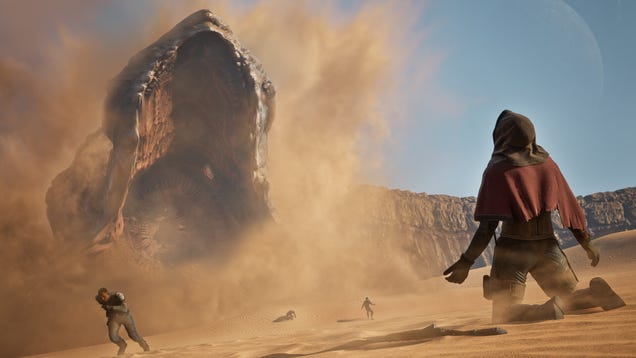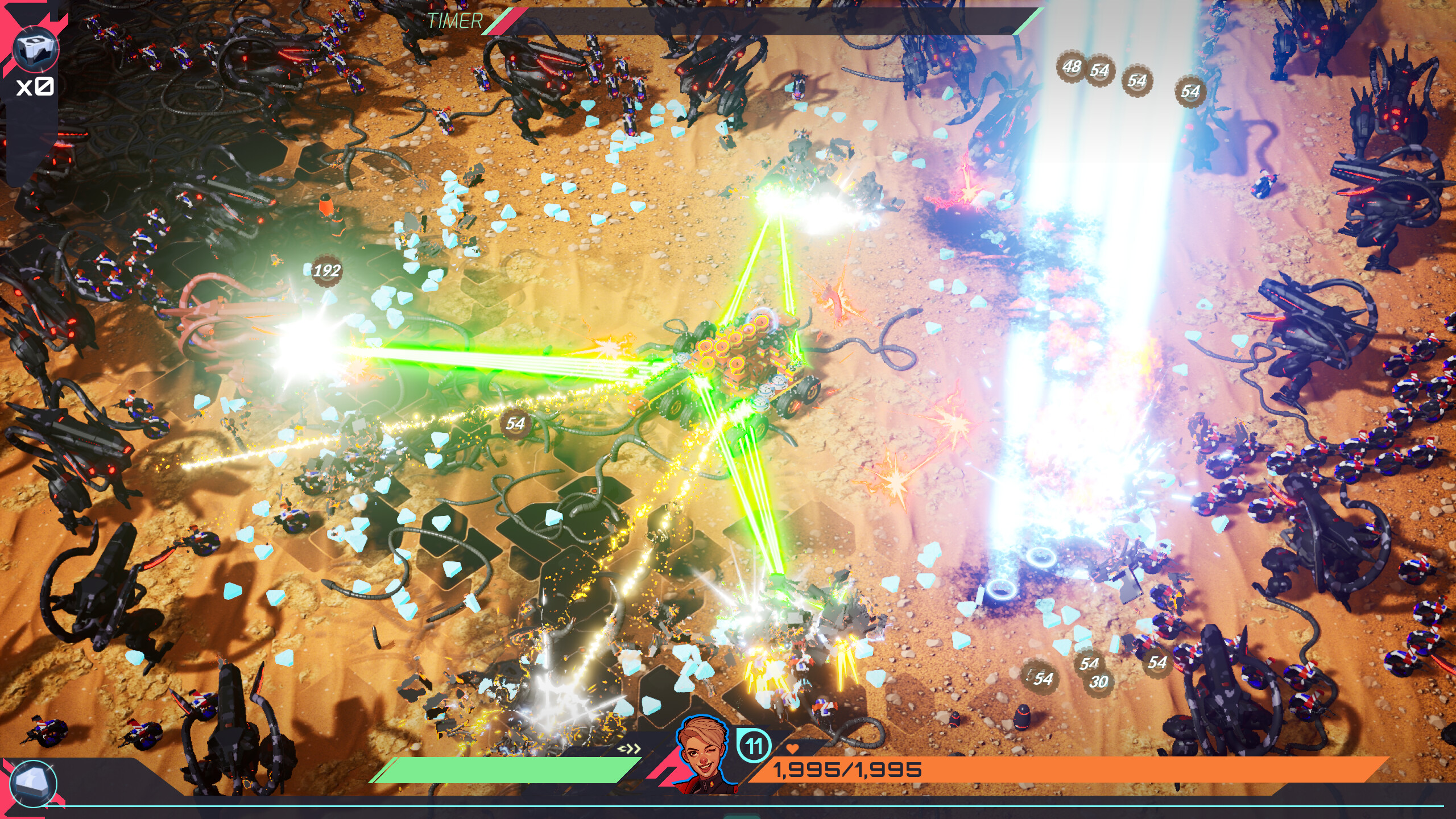
Feelings of glee and wonder not unlike walking into an arcade full of classic games befell me as I booted up Atari 50: The Anniversary Celebration, gawking at its wide and varied wonders. This collection offers a completely new, very fun way to explore several decades of Atari arcade machines, consoles, handhelds, and PCs. With no musty old, red museum ropes to restrain me (only five of the 103 games require unlocking), I found myself not just absorbing, but exploring the past – like that chunky pixel in Adventure for the Atari 2600 gliding through rainbow-colored castles. Experiencing history in Atari 50 is like nothing else I’ve ever seen in any collection before, let alone a documentary, book, or a classroom. It’s all of those things in one, and a lot more fun!
If you’ve played a recent game collection, you know what they are about: A list of emulated games, sometimes presented with new save options, control schemes, and other adaptations – and often a sampling of digitized extras, like scans of box art. Atari 50’s creators, Digital Eclipse, are unparalleled collection creators. Their previous efforts, including the Mega Man Legacy Collection and Teenage Mutant Ninja Turtles: The Cowabunga Collection came packed with art and unearthed design documents in addition to presenting very playable versions of emulated games. In Atari 50, the historical artifacts are not buried in an extras menu on the home screen. Here, the extras menu is a game itself. Presented as a branching timeline, a single point of interest might be a playable game, a short documentary, a slideshow, a scan, a quote, or an artifact, all adding to an irresistible completion percentage as you delve deeper.
And what artifacts they are! Holograms from a canceled Atari handheld? Reproduced. A theatrical trailer for Yars’ Revenge? Presented in all of its grainy glory. The entire code for Combat on the Atari 2600? It fits in a single screenshot (the file size of which is many times larger than the original code). Airworld, the missing final game in the Swordquest series of action-adventure cartridges with DC Comics tie-ins? Created from scratch by Digital Eclipse and included. The video game market crash of the 1980s interrupted the series finale so Digital Eclipse made a game to right that historical wrong.
But What About The Games
There’s technically a better way to play many of these games, and that’s on their original hardware. This is especially true for Atari in the 80s, who avoided joystick layouts almost entirely in their arcade games (e.g. Centipede’s trackball, Asteroids’ all-button control panel, Tempest’s spinner) and got even weirder with their home consoles like the Atari 7800 and Atari Jaguar. But outside of a room full of restored hardware, such as a classic game convention or an arcade, there’s no better context to play these games in than this collection. Games are discussed in a documentary, presented alongside design docs and art, and for each one you are given a reason, or several, to try it out. It’s so much better than a folder of ROMs. And unlike the arcade games I mentioned above, some of these fare better in this format. I may be a stickler for getting classic arcade controls right, but I’m not a huge fan of the Atari 2600 joystick – it stinks! I’d rather play most of the console and PC games presented with smoothed-over controls mapped to modern D-pads and analog sticks.
Atari 50’s emulation has some but not all of the common, modern improvements seen in many collections: A single save state has been added for each game, controls can be remapped, a pretty good CRT-like filter can be enabled, bezels recreate art and fill out the wide screen. But you cannot rewind these games or watch and manipulate a perfect playthrough like we saw in 2022’s Cowabunga Collection. I’m surprised, since those specific features have become standard in Digital Eclipse collections and I believe they should become universally expected – but I also don’t miss them here as much, due to the largely arcade-y nature of the game list (and that includes games beyond the arcade years, I think there’s an Asteroids and/or a Missile Command on every Atari platform, many included here).
6 Must-Play Games
The subjects of the documentaries in Atari 50 will tell you about the classics: Star Raiders, Tempest 2000, Yars’ Revenge, and Warlords (four player!) are all very playable and presented well in this collection. But here are some weird and wonderful games you might not have thought to try, or simply couldn’t before now:
VCTR-SCTR (Reimagined)
Designed by Digital Eclipse and housed in an actual arcade cabinet for the California Extreme 2022 arcade convention, this is a vector graphics-inspired mashup of several Atari games like Asteroids and Lunar Lander. It looks sleek and the transitions between levels are pure vector-like joy.
Cloak & Dagger (Arcade)
A ridiculous tie in to a 1984 movie of the same name, Cloak & Dagger only appeared as a rare kit to convert older games in arcades. It has amusingly weird cutscenes and an easy-to-understand, simplistic infiltration theme. Cool!
Club Drive (Jaguar)
Club Drive is a very early 3D polygon game (think Star Fox) and involves a kind of casual, open-world driving. It’s a pretty remarkable tech accomplishment but also a fun foil to, say, Super Mario 64, which did 3D so much better just two years later. But did Super Mario 64 have 90s saxophone samples? Club Drive definitely does.
Black Widow (Arcade)
Black Widow is a twin-stick shooter like Robotron with goofy vector graphics. I adore this game.
Dodge ‘Em (2600)
It’s a simple concept: Two cars circle a track in opposite directions in a sort of chicken-meets-jousting match. It makes for a great two-player party game. Don’t miss the amusingly overwrought packaging art of a mustachioed buggy driver being run off the road. Sure!
Turbo Sub (Lynx)
Created for the Atari Lynx portable system, Turbo Sub is a crazy, in-your-face first-person shooter. But not that kind of FPS – in this you are a submarine AND a plane! And you can freely dive and soar while meeting objectives.
The list itself is dominated by Atari 2600 games (there are 40 of them) followed by arcade games (25), and the rest of the 103 total options are a mix from Atari consoles like the Atari 5200, 7800, and Jaguar, the handheld Lynx, and the Atari 400/800 PCs. Of these my favorites are all arcade games, but they also lose the most in emulation. With few exceptions, Atari 2600 games are hard for me to get excited about anymore. I’ve played them all, they are very simple – and if they aren’t simple, they require manuals, all thankfully provided here. I get their place in history, with wondrous creativity and programming tricks that make them so interesting, and that’s exactly what the Atari 50 collection provides for your enjoyment and perhaps education.
I was most intrigued by the “Reimagined” games, variants that are brand new to this collection, and some of the later Atari efforts, like the 3D Jaguar games. These did not disappoint… well, maybe some of them did; options like Cybermorph and Club Drive were and are disappointing games and commercial failures! But they are fascinating. 3D Jaguar games represent a pre- PlayStation or Nintendo 64 era that most people weren’t privy to due to the limited interest in the Jaguar stunting its ubiquity. These Jaguar games are full of goofy, rough edges, but I greatly appreciate the chance to play them.
License Revoked
There are some sad but likely necessary omissions from the Atari 50 collection: Atari’s masterpiece arcade game, Star Wars, and its vector sequel The Empire Strikes Back; Raiders of the Lost Ark for 2600; Alien vs Predator for the Jaguar. All of these, and many, many more beloved games based on popular licenses aren’t included here. You get E.T. the Extra-Terrestrial, so licenses weren’t totally prohibitive, but the story of Atari is incomplete without the iconic pop culture-inspired games. These are sometimes acknowledged in the documentaries, but even the extras are devoid of a single piece of that glorious era when the Atari and Star Wars logos appeared alongside some of the coolest, high tech games of the time.
MOAR GAMES?
Here’s a list of every game in the Atari 50 collection, arranged by platform – including how to unlock the 5 secret games. We reached out for comment on the possibility of adding games to the collection and Digital Eclipse provided the following statement”
We feel strongly that Atari 50: The Anniversary Celebration is a complete package that tells the story we want to tell and takes video game compilations in an exciting new direction. While we don’t have anything to announce at this time as far as further Atari 50 content, we are definitely keeping all of our options open and exploring what’s possible.
Docs Deluxe
A highlight of Atari 50 are interviews with Atari employees, devs, and other creators. There are some incredible pieces of footage of the Pong factory in the early 1970s, and interviews with Atari’s founder Nolan Bushnell then and now. Long-standing, tall-seeming tales – like the first Pong machine prototype jamming up with quarters at a local bar or the laissez-faire attitude toward drug use in the Atari offices – are addressed in their own segments, presented as individual stories and impressions rather than definitive history.
As the years progress, fewer people in the included documentaries are excited to talk about Atari, especially into the 1990s, and that era isn’t nearly as well documented as the 1980s in this collection, which is a shame because it’s not well documented overall. And while it’s amazing to capture some of the most prominent voices from Atari’s past, the selection of interview subjects is not fully representative of talent at the time. The Atari era boasted a number of prominent women developers, for example, but sadly none of them are featured in these documentaries I would be interested to hear from other Atari contributors; Atari’s art and marketing departments represented some of the company’s greatest creativity, but their stories remain tantalizingly untold. Likewise, decades of journalists, historians, and collectors could have been tapped to add context that’s missing here.






